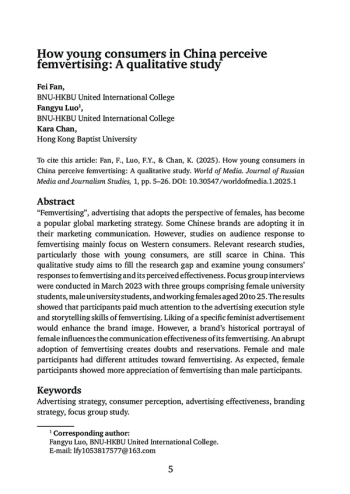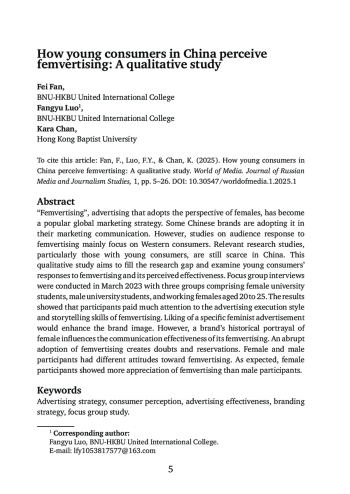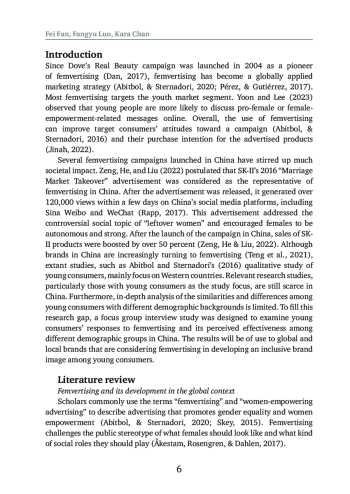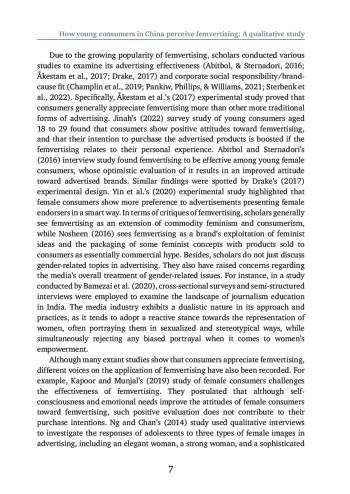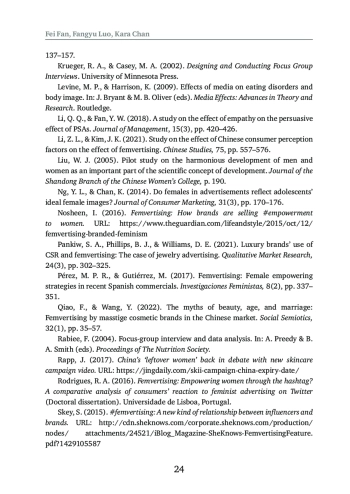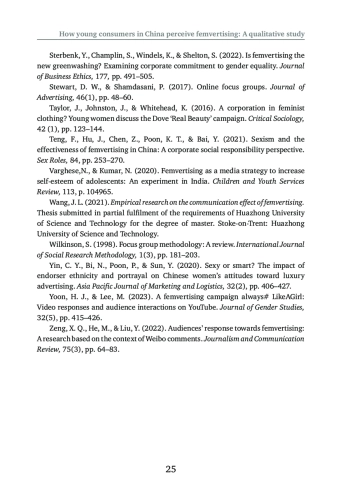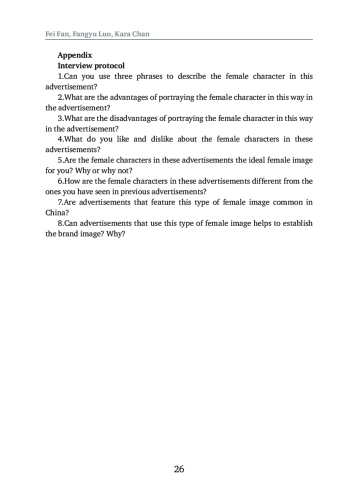“Femvertising”, advertising that adopts the perspective of females, has become a popular global marketing strategy. Some Chinese brands are adopting it in their marketing communication. However, studies on audience response to femvertising mainly focus on Western consumers. Relevant research studies, particularly those with young consumers, are still scarce in China. This qualitative study aims to fill the research gap and examine young consumers’ responses to femvertising and its perceived effectiveness. Focus group interviews were conducted in March 2023 with three groups comprising female university students, male university students, and working females aged 20 to 25. The results showed that participants paid much attention to the advertising execution style and storytelling skills of femvertising. Liking of a specific feminist advertisement would enhance the brand image. However, a brand’s historical portrayal of female influences the communication effectiveness of its femvertising. An abrupt adoption of femvertising creates doubts and reservations. Female and male participants had different attitudes toward femvertising. As expected, female participants showed more appreciation of femvertising than male participants.
Идентификаторы и классификаторы
Since Dove’s Real Beauty campaign was launched in 2004 as a pioneer of femvertising (Dan, 2017), femvertising has become a globally applied marketing strategy (Abitbol, & Sternadori, 2020; Pérez, & Gutiérrez, 2017). Most femvertising targets the youth market segment. Yoon and Lee (2023) observed that young people are more likely to discuss pro-female or femaleempowermentrelated messages online. Overall, the use of femvertising can improve target consumers’ attitudes toward a campaign (Abitbol, & Sternadori, 2016) and their purchase intention for the advertised products (Jinah, 2022).
Список литературы
1. Aaker, D. A., & Keller, K. L. (1990). Consumer evaluations of brand extensions. Journal of Marketing, 54(1), pp. 27-41. EDN: BHFGJL
2. Abitbol, A., & Sternadori, M. (2016). You act like a girl: An examination of consumer perceptions of femvertising. Quarterly Review of Business Disciplines, 3(2), pp. 117-138.
3. Abitbol, A., & Sternadori, M. (2020). Consumer location and ad type preferences as predictors of attitude toward femvertising. Journal of Social Marketing, 10(2), pp. 179-195. EDN: BMRSOU
4. Åkestam, N., Rosengren, S., & Dahlen, M. (2017). Advertising ‘like a girl’: Toward a better understanding of ‘femvertising’ and its effects. Psychology and Marketing, 34(8), pp. 795-806.
5. Bamezai, G., Roy, A., Roy, A., & Chhetri, S. (2020). Gender mainstreaming as an essential part of journalism education in India. World of Media. Journal of Russian Media and Journalism Studies, 3, pp. 1-33.
6. Bandura, A. (1977). Social Learning Theory. Prentice-Hall.
7. Bandura, A. (2001). Social cognitive theory of mass communication. Media Psychology, 3(3), pp. 265-299.
8. Caballero, J., & Fengler, M. (2023). China and India: The future of the global consumer market. URL: https://www.brookings.edu/articles/china-and-india- thefuture-of-the-global-consumer-market.
9. Champlin, S., Sterbenk, Y., Windels, K., & Poteet, M. (2019). How brand-cause fit shapes real-world advertising messages: A qualitative exploration of ‘femvertising’. International Journal of Advertising, 38(8), pp. 1240-1263. EDN: BNCILF
10. Chan, K., & Cheng, Y. (2012). Portrayal of females in magazine advertisements in Hong Kong. Journal of Asian Pacific Communication, 22(1), pp. 78-96.
11. Chen, Z. T.(2023). Bookreview: Afeministreadingof China’sdigitalpublicsphere.
12. Global Media and China. DOI: 10.1177/20594364231160106
13. Drake, V. E. (2017). The impact of female empowerment in advertising (femvertising). Journal of Research in Marketing, 7(3), pp. 593-599.
14. Duan, X. (2020). “The Big Women”: A textual analysis of Chinese viewers’ perception toward femvertising vlogs. Global Media and China, 5(3), pp. 228-246. EDN: SSGKWX
15. Guo, J., Zhang, Z., Song, J., Jin, L., Yu, D., & Liao, S. (2022). Femvertising and postfeminist discourse: Advertising to break menstrual taboos in China. Women’s Studies in Communication, 45(3), pp. 378-398.
16. Jinah, L. (2022). Empowering women or selling empowerment to women? Young consumers response to femvertising in the Japanese context. Keio Communication Review, 44.
17. Kapoor, D., & Munjal, A. (2019). Self-consciousness and emotions driving femvertising: A path analysis of women’s attitude towards femvertising, forwarding intention and purchase intention. Journal of Marketing Communications, 25(2), pp.137-157.
18. Krueger, R. A., & Casey, M. A. (2002). Designing and Conducting Focus Group Interviews. University of Minnesota Press.
19. Levine, M. P., & Harrison, K. (2009). Effects of media on eating disorders and body image. In: J. Bryant & M. B. Oliver (eds). Media Effects: Advances in Theory and Research. Routledge.
20. Li, Q. Q., & Fan, Y. W. (2018). A study on the effect of empathy on the persuasive effect of PSAs. Journal of Management, 15(3), pp. 420-426.
21. Li, Z. L., & Kim, J. K. (2021). Study on the effect of Chinese consumer perception factors on the effect of femvertising. Chinese Studies, 75, pp. 557-576. EDN: KBZAFH
22. Liu, W. J. (2005). Pilot study on the harmonious development of men and women as an important part of the scientific concept of development. Journal of the Shandong Branch of the Chinese Women’s College, p. 190.
23. Ng, Y. L., & Chan, K. (2014). Do females in advertisements reflect adolescents’ ideal female images? Journal of Consumer Marketing, 31(3), pp. 170-176.
24. Nosheen, I. (2016). Femvertising: How brands are selling empowerment to women. URL: https://www.theguardian.com/lifeandstyle/2015/oct/12/femvertising-branded-feminism.
25. Pankiw, S. A., Phillips, B. J., & Williams, D. E. (2021). Luxury brands’ use of CSR and femvertising: The case of jewelry advertising. Qualitative Market Research, 24(3), pp. 302-325. EDN: HANMLU
26. Pérez, M. P. R., & Gutiérrez, M. (2017). Femvertising: Female empowering strategies in recent Spanish commercials. Investigaciones Feministas, 8(2), pp. 337- 351.
27. Qiao, F., & Wang, Y. (2022). The myths of beauty, age, and marriage: Femvertising by masstige cosmetic brands in the Chinese market. Social Semiotics, 32(1), pp. 35-57.
28. Rabiee, F. (2004). Focus-group interview and data analysis. In: A. Preedy & B.
29. Smith (eds). Proceedings of The Nutrition Society.
30. Rapp, J. (2017). China’s ‘leftover women’ back in debate with new skincare campaign video. URL: https://jingdaily.com/skii-campaign-china-expiry-date.
31. Rodrigues, R. A. (2016). Femvertising: Empowering women through the hashtag? A comparative analysis of consumers’ reaction to feminist advertising on Twitter (Doctoral dissertation). Universidade de Lisboa, Portugal.
32. Skey, S. (2015). femvertising: A new kind of relationship between influencers and brands. URL: http://cdn.sheknows.com/corporate.sheknows.com/production/nodes/attachments/24521/iBlog_Magazine-SheKnows-FemvertisingFeature. pdf?1429105587.
33. Sterbenk, Y., Champlin, S., Windels, K., & Shelton, S. (2022). Is femvertising the new greenwashing? Examining corporate commitment to gender equality. Journal of Business Ethics, 177, pp. 491-505. EDN: YAAISR
34. Stewart, D. W., & Shamdasani, P. (2017). Online focus groups. Journal of Advertising, 46(1), pp. 48-60.
35. Taylor, J., Johnston, J., & Whitehead, K. (2016). A corporation in feminist clothing? Young women discuss the Dove ‘Real Beauty’ campaign. Critical Sociology, 42 (1), pp. 123-144.
36. Teng, F., Hu, J., Chen, Z., Poon, K. T., & Bai, Y. (2021). Sexism and the effectiveness of femvertising in China: A corporate social responsibility perspective. Sex Roles, 84, pp. 253-270. EDN: ZKBMSY
37. Varghese,N., & Kumar, N. (2020). Femvertising as a media strategy to increase self-esteem of adolescents: An experiment in India. Children and Youth Services Review, 113, p. 104965. EDN: WTDIEY
38. Wang, J. L. (2021). Empirical research on the communication effect of femvertising. Thesis submitted in partial fulfilment of the requirements of Huazhong University of Science and Technology for the degree of master. Stoke-on-Trent: Huazhong University of Science and Technology.
39. Wilkinson, S. (1998). Focus group methodology: A review. International Journal of Social Research Methodology, 1(3), pp. 181-203.
40. Yin, C. Y., Bi, N., Poon, P., & Sun, Y. (2020). Sexy or smart? The impact of endorser ethnicity and portrayal on Chinese women’s attitudes toward luxury advertising. Asia Pacific Journal of Marketing and Logistics, 32(2), pp. 406-427.
41. Yoon, H. J., & Lee, M. (2023). A femvertising campaign always # LikeAGirl: Video responses and audience interactions on YouTube. Journal of Gender Studies, 32(5), pp. 415-426.
42. Zeng, X. Q., He, M., & Liu, Y. (2022). Audiences’ response towards femvertising: A research based on the context of Weibo comments. Journalism and Communication Review, 75(3), pp. 64-83.
43. Dan, A. (2017). Dove invented ‘femvertising’ but its latest stunt didn’t wash with consumers. URL: https://www.forbes.com/sites/avidan/2017/05/11/dove-invented-femvertising-but-its-latest-stunt-didnt-wash-withconsumers/?sh=4f2ad0d756b6.
Выпуск
Другие статьи выпуска
The article aims to outline bloggings as a complex social phenomenon and identify the current role of blogs in virtual reality. The literature review revealed that the evolving paradigm of civilizational growth has led to a hybrid environment, which combines the aspects of physical world and virtual reality artefacts, resulting in a unique media landscape, significantly impacting sociocultural and communicative dynamics. However, the field lacks studies on typical features of blogosphere, such as its inherent openness, fostering informal communication, intention to both monetization and self-expression. To address the study’s objectives the research adopts an integrative interdisciplinary approach, including socio-philosophical and semiotic cultural studies, theory of computer communication, network and Internet discourse studies to use data from various fields of humanitarian knowledge. It is concluded that originally created as online diaries, currently blogs as a diverse media platform demonstrate several unique features, including high personalization, audience feedback capabilities, constant user engagement with various types of information (verbal, audial, visual). These characteristics positioned blogs as key contributors to the growth of virtual sociality, leading to the emergence of a new type of society characterized by heightened human sensory experiences and the development of new empathetic models and behavioral attitudes. A notable sign of these changes is that the audience’s attention has shifted from professional media institutions to individual bloggers, who are increasingly adopting media-like behaviors. The current research adopts an interdisciplinary approach, merging socio-philosophical and semiotic cultural studies, as well as with theory of computer communication, network and Internet discourse studies. It also employs methods of Internet linguistics and the principles of pragmalinguistics; the axiological method helps to identify value-based sociocultural guidelines within the framework of globalization.
This study aims to investigate the impact of avatar identification on the intention to share by examining the mediating role of user immersion and the moderating effect of perceived social distance. For this, we collected 228 higher education students in South Korea through a survey and used hierarchical regression with SPSS 24.0. In the results, first, it showed that participants who perceived higher levels of similarity identification, wishful identification, and embodied presence in their avatars in the metaverse platform were more immersed in their avatars. Second, participants who perceived greater embodied presence in their avatars had a stronger intention to share their avatars through immersion. Finally, the positive relationship between perceived embodied presence and immersion was more significant for participants in metaverse platforms with higher perceived social distance compared to those with lower perceived social distance. This study is the first to examine the integral model of avatar identification factors in the metaverse platform. And, this study’s results show the mechanism by which avatar identification enhances the intention to share.
In order to promote cultural variety, encourage local involvement, and provide a voice to underrepresented groups, community radio stations (CRS) have become essential venues. Using information from 339 publications in the English language indexed in the Scopus database between 2000 and 2024, this bibliometric analysis attempts to map the research landscape on CRS methodically over the previous 20 years. This timeframe was chosen to capture significant developments in community radio stations, including policy shifts, technological advancements, and the rise of CRS movements in regions like South Asia, Africa, and Latin America. The analysis pinpoints important patterns in the field’s publication output, research hotspots, significant writers, and foundational publications. The data shows a consistent rise in scholarly interest, especially concerning the contribution of CRS to media democratization, community empowerment, and social transformation. A thematic analysis reveals recurrent research themes, such as CRS’s role as an alternative medium, how it affects local development, and the difficulties it faces in maintaining operations. Citation analysis reveals patterns of scholarly collaboration by highlighting the most significant publications and the growth of research networks. This study highlights how CRS has influenced the media environment and how they might support community-based projects. This work advances theoretical knowledge of CRS’s development and continued significance by thoroughly analyzing the scholarly discourse on the subject.
Статистика статьи
Статистика просмотров за 2025 год.
Издательство
- Издательство
- МГУ
- Регион
- Россия, Москва
- Почтовый адрес
- оссийская Федерация, 119991, Москва, Ленинские горы, д. 1
- Юр. адрес
- оссийская Федерация, 119991, Москва, Ленинские горы, д. 1
- ФИО
- Садовничий Виктор Антонович (РЕКТОР)
- E-mail адрес
- info@rector.msu.ru
- Контактный телефон
- +7 (495) 9391000
- Сайт
- https://msu.ru/
